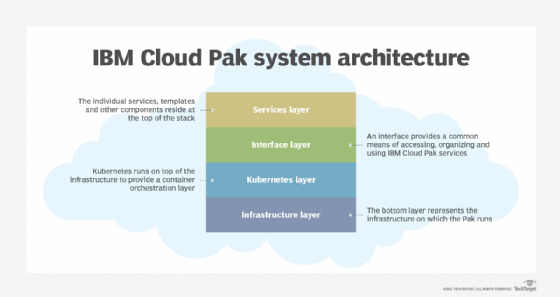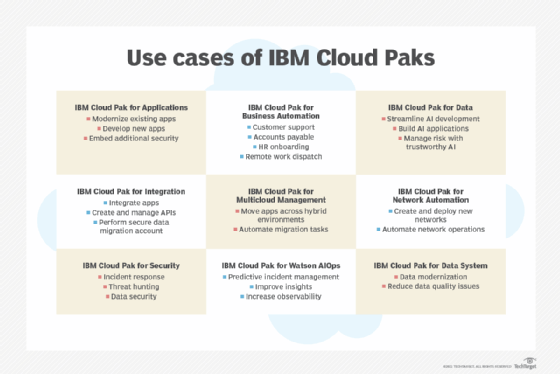
Getty Images/iStockphoto
9 IBM Cloud Paks for app modernization and cloud efforts
While businesses seek benefits in outsourced and scalable infrastructure and services, moving to cloud creates challenges in workload modernization. See if IBM Cloud Paks can help.
It takes time, money and labor to update, modernize and re-architect applications and workflows to use cloud environments.
For many longstanding businesses, core and mission-critical applications are dated monolithic applications that were designed for traditional data center deployments on physical servers. Those applications may not work well in the public cloud -- and sometimes not at all. The work involved in modernization initiatives has made cloud adoption slow and spotty, not to mention a risk that business leaders loathe to take.
IBM brings a new dimension to cloud adoption with highly integrated end-to-end solution stacks that can provide a range of typical business processes and workflows for business users. Learn what IBM Cloud Paks are and the nine different types available that can ease some challenges of cloud modernization, help businesses migrate and even support advanced cloud models.
What are IBM Cloud Paks?
IBM Cloud Paks are groups of services that are related by topic or purpose, such as data, integration, applications, automation and so on. Ideally, these services can accomplish common enterprise tasks without the need to build or modernize existing applications.
IBM Cloud Paks have several unique attributes that set them apart from other everyday cloud services:
- Containerized. Where most cloud services employ VM architectures, IBM Cloud Paks use container technology to provide their suite of services. Containers offer lightweight resource use, fast scalability and high portability.
- Layered. The IBM Cloud Pak system is composed of several distinct layers. The bottom layer represents the infrastructure on which the Paks run. Kubernetes runs on the infrastructure to provide a container orchestration layer. An interface provides a common means of accessing, organizing and using IBM Cloud Pak services. The individual services, templates and other components reside at the top of the stack.
- Portable. The use of containers and underlying Kubernetes orchestration provides a common operating environment for IBM Cloud Pak components. This enables Cloud Paks to run anywhere that Kubernetes is already running.
- Variety. A Cloud Pak can include dozens of containerized components that include a mix of recognized IBM services, IBM middleware and open source components. Each component is validated to interoperate across a range of infrastructure from hardware to applications.
- Organized. The components of an IBM Cloud Pak are typically organized to support common business goals.

Today, there are nine distinct Cloud Paks available. Organizations can adopt one or more Cloud Paks to help meet an array of business goals that utilize cloud computing paradigms.
1. IBM Cloud Pak for Applications
Businesses rely on applications for revenue and everyday operations, but the move from traditional data centers to cloud-based deployment models demands tremendous effort in application modernization.
IBM Cloud Pak for Applications provides an array of tools and services that help businesses modernize applications and create new cloud-native applications for public, private and hybrid clouds using Kubernetes-based containers. The Pak includes an assortment of key platforms and components suited for application support, including the following:
- IBM WebSphere Application Server Network Deployment;
- IBM WebSphere Application Server;
- IBM WebSphere Application Server Liberty Core;
- Red Hat OpenShift plus Red Hat Runtimes;
- modernization tools, such as IBM Cloud Transformation Advisor and IBM WebSphere Migration Toolkit; and
- IBM Mobile Foundation.
IBM Cloud Pak for Applications can help with an assortment of use cases. For example, it can modernize existing WebSphere environments to new IBM container platforms or help build and modernize mobile applications. Businesses can run new and existing workloads simultaneously to ease transitions and mitigate risk. Applications created with the Pak can be deployed on WebSphere Application Server, IBM Cloud Private, Red Hat OpenShift and IBM MobileFirst Platform Foundation.
2. IBM Cloud Pak for Business Automation
Businesses depend on processes and policies to support everyday operations and keep the business running smoothly. Business automation helps achieve and maintain faster and more consistent business-client outcomes.
IBM Cloud Pak for Business Automation offers a set of services and capabilities designed to discover processes, find bottlenecks or inefficiencies, apply AI and automation to processes, and streamline processes to improve efficiency and reduce errors. The Pak provides a broad array of automation tools and capabilities, including the following:
- content services to find and organize content;
- decision services to drive decision-making processes;
- Application Designer for UI creation;
- Automation Digital Worker for AI tasks; and
- Automation Workstream Services to create and manage workflows.
IBM Cloud Pak for Business Automation can be used for an array of business tasks, such as automating employee onboarding, receiving and addressing compliance data requests, and implementing consistent means for managing business data.
3. IBM Cloud Pak for Data
Data is the gateway to business analytics and AI, but businesses struggle to manage and maintain vast amounts of complex data spread across different data sources. At the same time, the lifespan of data is shrinking.
IBM Cloud Pak for Data provides a cloud platform that can help businesses find, manage and use data effectively. The Pak supports multi-cloud environments, including AWS, Azure, Google Cloud, IBM Cloud and private cloud deployments. The Pak offers data management, data governance, analytics and AI capabilities, while supporting extensible and customizable capabilities from an array of services, including the following:
- AutoAI for automated data and model development, as well as lifecycle management;
- AutoSQL automates the way data is accessed, managed and maintained across stores and clouds;
- AutoCatalog automates the way data is discovered, organized and processed; and
- AutoPrivacy establishes and enforces data access and usage policies.
IBM Cloud Pak for Data can be employed in use cases such as data store convergence, data ops, data privacy and data security management, and AI governance.

4. IBM Cloud Pak for Integration
Modern businesses depend on growing stables of enterprise applications -- each often with different data stores. Integration applications and data need to work together seamlessly. Traditional integration is typically slow, hard to scale and depends on detailed developer knowledge.
IBM Cloud Pak for Integration provides a set of tools and services that can help businesses integrate applications and data similar to integration PaaS technologies. The Pak is designed to support tasks such as API management and application integration, as well as enterprise messaging and event-driven application development. The Pak provides an array of features and tools, including the following:
- IBM API Connect to secure and manage the API portfolio across multiple clouds;
- IBM App Connect to integrate applications and data, regardless of location;
- IBM MQ for enterprise messaging;
- IBM Confluent Platform for event-driven application development;
- IBM Aspera for high-speed data transfer; and
- IBM DataPower Gateway for end-to-end security.
The principal use cases for the Pak focus on application and data integration tasks. For example, integration can help to normalize or pre-process data so that multiple applications can share a common data store. Similarly, integration can streamline and automate workflows that depended upon time-consuming and error-prone manual data manipulation and transfer processes.
5. IBM Cloud Pak for Multicloud Management
A single cloud may not have the features, capabilities and availability needed to support the demands of an enterprise. Businesses increasingly adopt a multi-cloud strategy to have access to unique offerings or enable the resilience required for cloud-based workloads. However, using numerous clouds multiplies the complexities of cloud management.
IBM Cloud Pak for Multicloud Management helps provide consistent visibility, control, automation and governance across multiple cloud environments. The Pak supports integration with existing tools and processes, along with event, infrastructure, cluster and edge management. The Pak provides or supports an assortment of tools and capabilities, including the following:
- IBM Netcool Ops Manager;
- Monitoring Module;
- Terraform & Service Automation Module;
- CloudForms; and
- Red Hat Ansible Tower.
IBM Cloud Pak for Multicloud Management is based on the idea of personas, where use cases are categorized by the roles most associated with multi-cloud management. The Pak defines five roles: Developer, Ops, IT Admin, Site Reliability Engineer (SRE), and Security and Compliance Engineer. Common tasks are grouped by role. For example, a developer has the tools to provision resources to create and manage cloud applications or monitor application performance. Similarly, an SRE can receive notifications for cluster and application incidents, check resource usage and manage Kubernetes pods.
6. IBM Cloud Pak for Network Automation
Networks are traditionally static entities consisting of discrete physical and virtualized appliances, as well as resources. These components are assembled and configured to form a network infrastructure that typically requires time-consuming manual intervention to update or change -- resulting in security and compliance problems for the business.
IBM Cloud Pak for Network Automation brings virtualization, management and automation to the network. The Pak is based on network functions virtualization technology, which is capable of discovering, virtualizing, organizing and provisioning network resources to speed network management tasks, while reducing errors. The Pak includes components such as the following:
- Site Planner;
- IBM Automation Foundation;
- Telco Network Cloud Manager;
- AI Manager;
- Metric Manager; and
- Event Manager.
IBM Cloud Pak for Network Automation has several possible use cases generally intended to benefit communications service providers. For example, the Pak can help speed the creation and deployment of new networks and network services -- tasks that usually took days and required hands-on configuration changes can be performed remotely. Similarly, the ability to orchestrate and automate common network tasks can reduce network maintenance and management costs for the business.
7. IBM Cloud Pak for Security
Businesses of all sizes grapple with the threat of data theft and other malicious activity. Security experts are challenged to secure data, monitor the environment and take effective action when threats emerge.
IBM Cloud Pak for Security offers an array of features and capabilities intended to help security experts identify, understand and address threats. Also, it assists experts to secure and manage data centrally, regardless of its physical location, as well as employ orchestration and automation to respond to existing and emerging threats. IBM Cloud Pak for Security includes applications and tools such as the following:
- IBM Security Data Explorer for federated search and investigation;
- IBM Security Threat Intelligence Insights for threat intelligence;
- IBM Security Case Management to track, manage and resolve security incidents;
- IBM Security Orchestration & Automation to integrate security tools and automate responses;
- QRadar Security Intelligence Platform for security analytics; and
- QRadar User Behavior Analytics for detecting insider threats.
IBM Cloud Pak for Security is designed to serve three fundamental use cases. Security experts can use the Pak to secure business data, hunt for threats and handle incident response.
8. IBM Cloud Pak for Watson AIOps
As the pace of business accelerates and the scope of operations expands beyond the walls of traditional data centers, IT experts need tools to understand, optimize and manage sprawling environments. At the same time, IT teams must respond faster and minimize errors. AI is used in operations (AIOps) to bring greater intelligence, orchestration and automation to operations tasks.
IBM Cloud Pak for Watson AIOps includes a range of features and capabilities associated with AI and operations tasks, including the following:
- guided tours for new users;
- AI management;
- ChatOps;
- AI models and training;
- data ingestion to support analytics and AI;
- application management; and
- event/incident management.
IBM Cloud Pak for Watson AIOps supports several principle use cases. It can help IT staff work proactively to identify and remediate incidents before applications are impacted. It also improves insight and observability across the environment by analyzing multiple data sources. Prompt incident identification and remediation can help manage costs. And, finally, the ability to oversee and manage IT environments is increasingly central to corporate governance and compliance.
9. IBM Cloud Pak for Data System
Businesses are increasingly using data to make business decisions, as well as train and maintain AI systems. But such efforts demand a significant investment in hardware and software stacks.
IBM Cloud Pak for Data System offers an integrated solution that includes both hardware and software that supports the collection, organization and analysis of business data. The offering is based on a Lenovo ThinkSystem SD530 combining compute, storage, networking and software using an array of SD530 server nodes and interconnected with high-speed fabric switch networking. The system is designed to replicate cloud flexibility, enabling businesses to employ pay-as-you-go utilization schemes. The Pak includes a wide array of software and platforms intended to support data analytics, including the following:
- Red Hat OS;
- platform management tools for system management, monitoring and alerting;
- platform support for help, resource management, configuration and communication;
- Red Hat OpenShift to support containers and Kubernetes;
- Cloud Pak for Data System Edition, which includes a data and analytics platform and data governance features; and
- Netezza for data warehousing and analytics.
IBM Cloud Pak for Data System is a plug-and-play data analytics system. For example, the Pak is suited for business data modernization strategies, such as moving data from legacy databases onto modern databases. This is especially true when dealing with increasing amounts of unstructured data, such as images, audio, social media and so on. Data modernization helps to make data more accessible and easier to analyze. As another example, DataOps objectives can help to ensure data integrity, quality and governance, which also lead to better analysis, as well as machine learning and AI outcomes.
Test and caution
By making it easier to use the cloud, more businesses will use the cloud, and cloud providers have made substantial investments in developing services and capabilities designed to support cloud migration and use. But any kind of cloud transition should be carefully evaluated for suitability, resilience and long-term lock-in before a cloud commitment is made. Business leaders must consider alternatives and contingencies when relying on vendor partners for critical services. This involves careful testing and proof-of-principle initiatives, but it also demands a long-term assessment of the provider's roadmap and its impact on the business.
As one example, consider that v.5.1 of Cloud Pak for Applications currently states support of services through 2030. Within that time, versions, releases and services can change; new offerings can be added, while other services or components may be deprecated. There may be disruption to the business when a provider makes changes or discontinues offerings.







